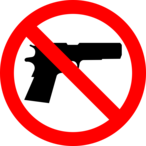
It Is ILLEGAL To Carry A Firearm In Any State Prohibited Area
State prohibited areas are listed in 53-5-710. Even if you have a concealed firearm permit, you cannot carry in ANY of these locations unless you are exempt under 76-10-523.
Prohibited areas do not include businesses that post “No Weapon” or “No Firearms” signs
More Information About No Weapon Signs
Simple Explination
Firearms and other dangerous weapons are prohibited:
Subsection 1 –
- (a) In a hearing room of a higher education institution (colleges and universities), correctional facility, law enforcement facility, mental health facility, and in any court
- (b) In any airport secure area (in or past the security checkpoint)
- (c) In any church or someone’s home if they notify you verbally, put up “no firearms” signs, or if the church is listed on the BCI website.
Subsection 2 –
- Anyone who is 18 to 20 years old with a valid provisional concealed firearm permit CANNOT carry a firearm on the property of any public or private elementary or secondary school. This includes ALL kindergarten through 12th-grade schools.
Very Detailed Explination
53-5-710. Cross-references to concealed firearm permit restrictions.
(1) A person with a permit of any kind to carry a concealed firearm may not carry a concealed firearm in the following locations:
(a) any secure area prescribed in Section 76-10-523.5 in which firearms are prohibited and notice of the prohibition posted;
76-10-523.5 has multiple laws. Although it’s a very long explanation and takes a while, we will make it easier to understand by breaking everything down into each Subsection and explaining them in detail.
[mirror_widget id=”18792″]
This law also includes multiple other laws.
- Title 53, Chapter 5, Part 7, Concealed Firearm Act1
- 53B-3-1032
- 76-8-311.13
- 76-8-311.34
- 78A-2-2035
1 Title 53, Chapter 5, Part 7, Concealed Firearm Act
This law is not a restrictive law. It is the law that talks about the Firearm Review Board, the Bureau of Criminal Identification within the Department of Public Safety, provisional concealed firearm permits, temporary permits, regular concealed firearm permits, renewals, and other basic permit information. The sentence is simply saying that anyone that has a concealed firearm permit no matter what type of permit (provisional, regular or temporary) has to follow the rules of secure areas that prohibit firearms that are described in the following laws.
2 53B-3-103: Higher Education Institution - Hearing Room
3 76-8-311.1 Secure areas -- Items prohibited -- Penalty.
Secure areas explain themselves as we go through the laws below which describe the prohibited locations, but we add some information to make some things better to understand. You are prohibited from carrying a firearm in all of the locations listed below.
4 76-8-311.3 Items prohibited in correctional and mental health facilities -- Penalties.
5 78A-2-203. Rules -- Right to make -- Limitation -- Security.
53-5-710 (b) Airport Secure Areas
53-5-710. Cross-references to concealed firearm permit restrictions.
(1) A person with a permit of any kind to carry a concealed firearm may not carry a concealed firearm in the following locations:
(b) any airport secure area as provided in Section 76-10-529;
[mirror_widget id=”19486″]
53-5-710 (c) House Of Worship Or Private Residence
53-5-710. Cross-references to concealed firearm permit restrictions.
(c) any house of worship or in any private residence where dangerous weapons are prohibited as provided in Section 76-10-530.
53-5-710 (2) Provisional Concealed Firearm Permit - School Premises
53-5-710. Cross-references to concealed firearm permit restrictions.
(2) Notwithstanding Subsection 76-10-505.5(2), a person under the age of 21 with a permit of any kind to carry a concealed firearm may not carry a concealed firearm on or about school premises, as defined in Subsection 76-10-505.5(1)(a).
